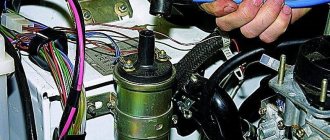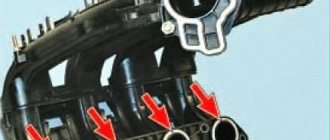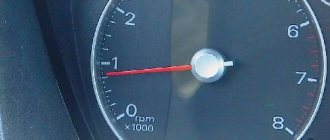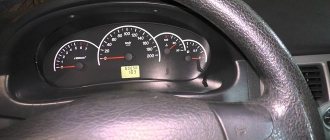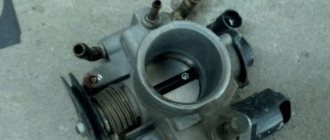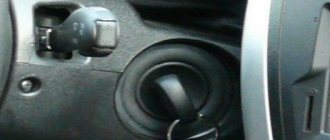Removing fuel injectors for inspection
The problem lies in the engine management system, where many errors popped up.
Electronic control unit
To eliminate the causes, it is necessary to check all nodes step by step until the problem is identified.
What to do first
You should start, oddly enough, by checking the presence of fuel in the gas tank, and you should also make sure that the anti-theft system is turned off.
It is possible that you were mistaken for a car thief. These are the simplest solutions to the problem, but unfortunately, they are also the rarest. Next, if the car continues to stall immediately after you start it, check to see if the fuel tank pump is working. To do this, put someone behind the wheel, open the tank cap, and ask an assistant to turn on the ignition without starting the engine. In the first seconds after turning on the ignition, you should hear the pump running. If you don't hear it, the pump may be faulty. It’s also worth checking the fuel filter, especially if you haven’t changed it in a while.
In addition, an air bubble in the fuel system may cause the engine to spontaneously stop immediately after starting. And solving this problem is much more difficult. Often you have to push the car or tow it in order for the engine to start. But all this is possible only for cars with a manual transmission.
Ignition and spark plugs
An incorrectly set ignition timing can cause the engine to stall, including stalling immediately after starting. But ignition is a problem that manifests itself in any mode of engine operation. The engine will shoot, sneeze, malfunction and trip, in general, it will not work stably. Therefore, problems with the ignition system most likely will not be able to take you by surprise.
By refusing to work immediately after starting, the car may subtly hint to you that it is time to replace the spark plugs. True, in this case, failures and other violations will appear in other operating modes.
Due to a clogged injector, the car can also start and immediately stall. It is better to clean the injector by dismantling it and mechanically cleaning it. The fact is that the chemistry used for such purposes can dissolve the dirt and soot that clogged the injector, but does not remove them. And even the designer of this engine will not tell you where this very dirt will end up.
In rare cases, a completely clogged air filter can cause similar symptoms. But this is rather an exception, and checking it is not so difficult. Just run the engine for a minute without the air filter.
Electrics
Initially, it is necessary to check the normal voltage supply to the spark plugs. This is not difficult to do: unscrew each of them, and, leaning it against the ground, turn the starter. The spark should have a white-blue hue, be strong and stable. If one (or more) of the spark plugs is oily, the cylinders will not work fully. As a result, the engine starts and begins to “trouble” (the car vibrates), and then stalls.
High voltage wires
Their insulation may be damaged, which “guarantees” a breakdown between the “ground” of the car and the current-carrying conductor. As a result, the spark on the candles may be weak or completely absent. To check the functionality of high-voltage wires, drive the car into a dark room and start the engine with the hood open. Sparking in the explosive area indicates the need to replace them.
Battery
The electrical system of a modern car contains enough devices that require a stable voltage to power them.
Electronic components
Perhaps the most common reason that a car starts and immediately stalls is the failure of the idle air regulator or IAC. But it is not always necessary to immediately change the IAC; in some cases, oxidation of contacts and other completely removable problems occur. However, the failure of the idle air control valve is usually not indicated on the dashboard and the Check Engine light does not light up either. You can determine that the problem is in this particular unit by the floating speed in idle mode.
In addition, the following sensors can create problems with the operation of the motor immediately after it starts:
More precisely, problems arise due to the failure or malfunction of one of these sensors. And of course, problems with the electronic engine control unit can cause the car to stall immediately after starting. As a rule, to troubleshoot problems in electronic systems and components of a car, you will need the help of a qualified specialist. Because, in addition to correctly carried out replacement, a number of electronic components may require some adjustments, calibration and other preparatory procedures.
When the throttle and crankshaft position sensors fail, the Check Engine indicator usually comes on.
Unfortunately, faults in car electronics are difficult to repair on your own. Moreover, it is not always and not always easy to find a specialist who is able to quickly and, most importantly, correctly determine the cause of a car breakdown and eliminate it just as quickly and efficiently.
The VAZ Kalina stalls 2-4 seconds after starting
VAZ (Lada) Kalina 2004 - 2013
When starting the car, it stalls after 2-4 seconds. After resetting the controller with BK-State, it works perfectly. Until the next start. There are no errors. Sometimes there is a “rich mixture”.
- Kalina takes a long time to start - 3 answers
- In the morning it works for 2-3 seconds and then stalls, Kalina - 2 answers
- It revs itself in the morning at idle, Kalina – 6 answers
- The idle speed on the VAZ Kalina jumped up - 6 answers
- VAZ Kalina stalls when cold or in the cold - 5 answers
Well, here is only the correct diagnosis. And obviously not by the State.
I would generally recommend that you disable this BC; there was a case when, thanks to the STATE, I had to change the ECU. Disable it and try without it.
Malfunctions in the intake system
This refers to the air filter, intake manifold, and throttle valve. The first of the listed elements has the “property” of becoming clogged with dust and dirt over time. As a result, the engine receives a mixture in which there is little air (or no air at all) and the engine stops working immediately after starting.
As for the throttle valve, it makes sense to check the normal operation of the sensor that controls its position. Clogged intake lines are a rare occurrence and are usually associated with a poor air filter allowing contaminants to pass through.
Fuel and its quality
The banal lack of fuel in the tank is one of the reasons why the engine stops working immediately after starting. The fact is that the fuel pump begins to “grab” air and the engine stalls. This situation can also occur when there is fuel (5-7 liters) and the car is parked on a slope. Sometimes the reason why the power unit stops working after starting is water getting into the tank or low-quality fuel.
Diesel engines have their own nuance: using diesel fuel that does not correspond to the season - as a result, in winter, summer fuel will crystallize. In all cases, you will have to completely pump out the fuel and fill in new fuel: high-quality and appropriate for the time of year.
The next step is to check the functionality of the fuel pump. To do this, screw on the gas cap and have an assistant turn on the ignition. A running pump will make a characteristic sound: in some car models it can also be heard in the cabin. However, the buzzing of the device’s motor does not mean that it is fully operational. Often the reason for the lack of fuel in the combustion chamber lies in a clogged fuel pump filter mesh. To clean it, remove the device (usually it is located under the rear seat). If the car still stalls, it is worth checking the fuel filter (there are two of them: fine and coarse) and the injectors for clogging.
IAC cleaning
Do-it-yourself troubleshooting of the idle air regulator consists of simply washing it to remove carbon deposits. To do this you need to follow the instructions:
- disconnect the wire plug from the sensor;
- Unscrew the two fastening screws with a small shaped screwdriver and remove the sensor from the mounting socket;
- Clean the needle cone using WD-40 or carburetor cleaner.
The same means can be used to wipe the regulator contacts and the entire throttle assembly.
Throttle valve
When the driver presses the gas pedal, the throttle valve opens, allowing more air into the combustion chambers. Oxygen is mixed with fuel, after which the prepared mixture burns. The more the driver presses the gas pedal, the wider the throttle opens and the more air flows in. But often carbon deposits accumulate on the walls of the damper, and its loose closure causes disturbances in the operation of the power plant.
The throttle assembly is located behind the engine air filter. This arrangement is typical not only for the Lada Kalina, but also for many other cars. Depending on the engine type, the damper operation can be controlled by an electronic gas pedal or a cable drive.
Many car enthusiasts have come across the concept of floating engine idle speed. For the Lada Kalina, as practice shows, this is a common malfunction that can be fixed with your own hands, but sometimes you will need to use a car service.
RPM fluctuates at idle
This may be due to many factors.
Let's consider the main reasons for the occurrence of floating engine speeds:
- Fuel system malfunction
.Malfunction of fuel system elements
- Ignition problems
.Problems with the ignition switch or wiring
- ECU errors
.Troubleshooting ECU errors
- Poor quality fuel
.Low-quality gasoline directly affects the operation of the power unit
All these reasons contribute to the appearance of such an effect. The most common reason is problems with injection.
Treatment methods
So, let's consider the sequence of actions to eliminate the causes of floating engine speed.
Fuel system
As practice and experience show, floating speeds appear in the event of an uneven supply of fuel to the combustion chambers, or a constant change in the amount of the fuel mixture.
Cleaning a removed injector
First of all, this is due to the injectors, which may be dirty. At the same time, this may not be felt when driving, but at idle the tachometer will immediately show it. Therefore, it is necessary to dismantle and check the injectors on a special stand.
Clean fuel pump mesh
Also, the malfunction may be caused by a breakdown of the gasoline pump, which does not supply fuel evenly or a clogged fuel filter. If necessary, you need to replace the filter element and check the fuel pump.
Cleaning the throttle body
A change in the amount of fuel mixture may be due to a clogged throttle or worn air filter. Therefore, the filter element changes, and...
Removed throttle before and after cleaning
Ignition problems
Problems with idle speed may occur due to incorrect operation of the ignition system. Namely, it may be related to the lock or wiring. So, it is worth checking and, if necessary, replacing damaged elements. It is best to change the ignition switch assembly and test the wires that go from it to ensure they are working properly.
ECU errors
Often, a car malfunction is associated with, as well as a malfunction of the controllers on the board. Of course, another reason could be the firmware that is out of order. Many car enthusiasts change the operating system, but this does not always help.
ECU removed from the vehicle
As practice shows, an ECU malfunction can pose a problem for the performance of many systems. Therefore, if the fault cannot be eliminated using the previous methods, it is necessary to replace the control unit. Of course, installing the operating system from the Lada Kalina Sport K-Line can help, but the problem does not always disappear completely.
Poor quality fuel
In many cases, poor quality of the fill can cause clogging of the fuel pipeline and injection system, which in turn gives the effect of uneven fuel supply. To eliminate the malfunction, you should drain the old fuel, clean the fuel system and fill in with new high-quality gasoline.
It is worth understanding that not only the operation of the engine, but also its durability depends on the quality of the fuel.
The car stalls when you press the brakes and change gears
In the first case, the reason is obvious: a malfunction of the vacuum brake booster, which is responsible for supplying air to the intake manifold. If this happens improperly, the fuel mixture is not in the correct proportion and the car stalls. To be sure that the amplifier has failed:
- remove the hose connected to the manifold;
- plug the vacated hole with a suitable bolt;
- start the engine: if the situation has not changed, change the vacuum booster.
Other reasons for stopping the engine immediately after starting
Often the engine stalls after starting due to failures of the alarm system and anti-theft electronics. To put it simply, the immobilizer blocks the operation of the internal combustion engine, “considering” that this is a theft, that is, an unauthorized attempt to start the power unit. If the reason is the alarm, then try resetting the electronics error or disabling the anti-theft.
Every car enthusiast may encounter a problem when the car starts and stalls immediately after starting the engine. The driver's natural reaction will be to try to restart. As a rule, they do not lead to success and end with a complete discharge of the battery. The best thing to do when you notice your car is unable to maintain idle speed after starting is to find out the cause and fix the problem.
Primary diagnosis
When you turn the ignition key or press the Start button, the electrical system, consisting of a starter and battery, turns the engine shaft. Once the engine starts, it requires a constant flow of gasoline and a good spark to maintain combustion cycles. If there is not enough fuel entering the cylinders or there is not enough spark, the car will stall.
More modern vehicles are equipped with sophisticated computers that control all engine processes. These computers improve engine efficiency, but can force the engine to shut down if they detect any faulty systems.
Cars of older models are not so complex and, as a rule, easier to diagnose than modern ones, but on-board computers can provide information about the operation of the systems when a code scanner is connected.
The best place to start diagnosing why a car starts and then stalls is to identify the conditions under which the engine stalls, so you can then focus on the systems or components associated with failure within that specific condition. An unsuccessful start can occur under only one operating condition or several at once. For example, the engine stalls:
- immediately after launch;
- some time later;
- after a long stay;
- on a warm car;
- under any circumstances.
Conditions associated with the problem can provide clues as to which systems or components need repair. Regardless of whether the engine stops immediately after starting or the car starts and stalls after a few seconds. The cause of the malfunction may be:
- ignition or injection system;
- idle speed adjustment;
- carburetor or injector;
- depressurization of fuel or air lines;
- one or more sensors.
Common Problems
The best way to start diagnosing is to read the fault codes stored in the on-board computer's memory. This can be done at the nearest service station or yourself. If you don’t have a scanner, then you should think about purchasing one. Such devices are now relatively inexpensive.
Owners of old VAZ models will not need it, but owners of Priora and modern foreign cars will significantly improve the quality of self-diagnosis of faults.
Fuel and starvation
It is better to start diagnosing the line with the fuel filter. Check the compliance of the intervals in the service book and operating manual, take into account the impact on its service life of refueling the car with low-quality fuel or in risky places. If possible, use a fuel pressure sensor to check the circulation in the line. If the filter is clogged, it will need to be replaced. Likewise, an imbalance in the proportions of fuel and air caused by contamination of the injector or carburetor can cause the engine to stall at idle.
A large share of this type of problem is related to the fuel pump relay. This component affects the operation of the pump in the same way as a fuse. Before the start, the relay contacts close to start the electric drive of the pump and create the necessary pressure in the line. During and after the startup process, the relay is controlled by other systems. If the car's computer is not able to control the operation of the component during start and idle mode, the car will stall immediately.
Violation of the pump control algorithms may require reprogramming the on-board computer or replacing it. If the smart electronics are working properly, there may be other fuel delivery problems. The main components that can cause trouble:
- fuel pump;
- fuel injectors;
- coolant temperature sensor;
- fuel pressure control;
- crankshaft position sensor.
The last malfunction manifests itself by the ignition of the engine emergency warning lamp and disruption of the tachometer. Other problems are analyzed visually or using a scanner. Depressurization or obstruction of the fuel line can lead to malfunctions at idle speed.
It is important to remember that on cars with high mileage, the fuel pump itself is likely to become fatigued. Startup problems may be the first symptom that a complete component replacement is required.
Air mixture deficiency
It is always a good idea to check the throttle body and throttle plate for coking. If the damper valve is limited in movement, this can cause problems with engine operation at idle speed. Severe soot contamination can cause the engine to stall immediately after starting.
The throttle position sensor (TPS) plays a significant role in stable idle speed. This element controls the opening angle of the throttle valve and transmits this information to the electronic control unit. The computer uses this data, along with signals from other sensors, to control the air-fuel ratio, ignition timing and other parameters.
Troubleshooting options
It is clear that if any emergency situations arise with the motor, it is advisable to contact a specialized service. However, this procedure is not always possible. Therefore, it is worth knowing how to independently diagnose the main systems and key parts.
Throttle valve and assembly
When the speed drops at idle and the car stalls, you need to pay close attention to the details of the throttle assembly. Long-term operation of the car on low-quality fuel, untimely maintenance of the air filter can lead to malfunctions of the throttle valve
It periodically jams if debris gets into the equipment.
Throttle valve VAZ 2112
The problem can be solved by cleaning the system. The throttle is cleaned using carburetor cleaners. Using a compressor, you need to blow out the damper under the pressure of compressed air. It is not recommended to touch the screws located inside and on the side. If cleaning does not correct the situation, the device must be replaced. This operation is not particularly difficult.
Crankcase malfunction
There is an oil trap in the crankcase ventilation system of the engine. Its contamination can also lead to interruptions in engine operation. Crankcase gases do not allow the engine to function normally, the speed fluctuates, the internal combustion engine stalls.
Sensors
If a gasoline car stalls at idle, then one of the sensors is likely to break. In injection cars with an electronic engine control system, the engine usually starts normally, but then it stops working. It's worth checking here:
- Electronic car indicators;
- DRХХ – device that regulates idle speed;
- Air flow meter (air intake in the carburetor);
- Sensor indicating the position of the throttle curtain.
Electronic control unit in VAZ 2114
Interruptions in the operation of any sensors immediately affect the behavior of the electronics - errors appear in the car control unit. The “brains” of the machine receive unreliable information. It is not transmitted correctly to the engine. It starts working with parameters that do not correspond to reality. Self-testing of this device is not possible. You need to contact a professional for service.
Diagnostics of mass air flow sensor
The idle air control device is usually to blame for engine malfunction when the car idles poorly. But you pressed the gas pedal and the engine started. In the latest VAZ modifications, error information appears on the instrument panel.
When diagnosing, you must use a multimeter. If a part is faulty, it is recommended to replace it with a new one. All sensors are reasonably priced. It is better to start checking with parts that have a simpler design. Then gradually move on to complex devices. We must not forget that the problem may lie not only in the sensors themselves. It is also necessary to check the wiring to them and the presence of stable contact.
Carburetor
If the VAZ carburetor stalls at idle speed, then the jets may become clogged. Low-quality gasoline, deposits from the gas tank, contain small particles of debris. They can easily disrupt the operation of the fuel injection system. It is worth replacing the filter in front of the carburetor and cleaning the device itself. The dispensing part is cleaned using a cleaning solvent, which is sold in aerosol cans. Another reason is often a prolonged lack of carburetor adjustment.
In a mechanical fuel pump of carburetor cars, the filter mesh may be clogged with dirt. This reduces the performance of the device. Wear of the membrane and its destruction often leads to clogged carburetor channels.
Injector
A situation that often arises is that various Lada models, as well as the VAZ 2110 injector stalls at idle. It is necessary to check the fuel pump strainer for clogging. This is a common problem with injection machines. It is better to immediately replace the part with a working one.
Filter problem
If the VAZ 2112 stalls at idle, then the fuel filter may be dirty. This also applies to other models of the concern. Generally, it is not practical to clean it. The part must be replaced. The same should be done with a dirty air filter. Low throughput leads to the fact that the air-fuel mixture simply floods the spark plugs.
Self-checking will not always lead to a positive result. It is often more practical to identify the cause of unstable operation of the internal combustion engine at a car service center. It will cost more, but specialized diagnostics will prevent more serious damage to the car.
Diesel cars
Engines running on diesel fuel are more sensitive to depressurization of the fuel system than gasoline engines. The cause may even be small microcracks in the main pipes. The quality of fuel in the post-Soviet space often leaves much to be desired, so pollution is common:
- fuel tank;
- filter:
- injection nozzles.
One of the properties of diesel fuel is the ability to wax at low temperatures. If after starting the engine stalls immediately, then it is quite possible that this was due to the fuel system being clogged with paraffins. In this case, the most effective way is to move the car to a warm garage for a while. As preventive measures, it is recommended to timely refuel with winter fuel, add appropriate additives to the tank, and thoroughly prepare the vehicle for operating conditions at subzero temperatures.
The second common reason is also related to fuel quality. Most modern models are equipped with a particulate filter, which improves the vehicle's environmental performance. This system is designed to collect heavy carbon particles from exhaust and burn them under favorable circumstances.
If the car is used intensively and on low-quality diesel fuel, the particulate filter loses its ability to self-clean and becomes clogged to such an extent that it becomes a noticeable obstacle to exhaust gases. This leads to the fact that after taking readings from the sensors of the running engine, the on-board computer gives the command to turn off the engine, diagnosing its operation as an emergency. A clogged particulate filter cannot be repaired and must be replaced.
The most annoying reason why a diesel engine starts and stalls can be problems with the high pressure fuel pump. One of the first signs of impending fuel injection pump failure is unstable idling. Repair of this component should not be delayed; all procedures from diagnostics to replacement are best performed at specialized service stations.
If the exhaust gas recirculation valve has never been tested or has been tested for a very long time, then an unsuccessful diesel start is a good reason to diagnose this element. Carbon deposits and soot accumulation in the valve can immobilize or damage the diaphragm, which can significantly affect the stable operation of the engine.
In any case, if the car stalls after starting, the best decision would be to contact a service station. Most components do not fail on their own. Failure of their operation may be a sign of malfunction of other components or a harbinger of serious breakdowns. Branded network stations, in addition to competent personnel, have at their disposal both their own fault statistics and those coming from the manufacturer, which allows for error-free diagnostics.
Other reasons why a car won't start
If you are sure that everything is in order with the battery and oil, then you need to consider other possible causes of failure. It is quite possible that they will require additional time and effort from you. Let's look at the most common phenomena:
- problems with the fuel system. There can be many reasons for this, ranging from problems with the fuel pump to freezing of water in the fuel rail;
- failure of the antifreeze temperature control sensor, which also prevents the engine from starting when cold. In this case, it will need to be replaced;
- lack of tightness in the injectors. Depressurization is allowed at the level of 1-2 drops per minute, but no more. If depressurization occurs, the pressure in the fuel rail will quickly decrease after the engine stops, so if you manage to start, be sure to monitor this. In this case, you will have to install new injectors.
Separately, it is necessary to consider such a case as a drop in compression in the cylinders. Signs of a malfunction are easy to notice by the car’s behavior: engine power and dynamic performance drop significantly. The engine may rev and consume more fuel. It is not difficult to identify the problem; this requires a special device - a compression meter. It is recommended to visit a service station, where they will take measurements in compliance with all the rules, or you can do it at home.
If the pressure in the cylinders has collapsed, this often indicates wear and tear on the engine as a whole. Actually, there is a fairly simple way to check your guess. It is necessary to pour 1 tablespoon of oil into the hole for the candle, and then repeat the measurements. The results may be as follows:
- Sudden jump. This indicates that the piston rings are depressurized.
- Indications unchanged. There can be a lot of reasons for this, ranging from lack of valve tightness to burnout of the combustion chamber.
If the cylinder pressure is normal, then you need to take the car to a service station and carry out in-depth diagnostics of the engine; the problem is very serious.




